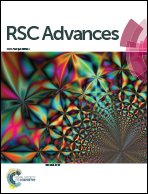Aerobic granular sludge-derived activated carbon: mineral acid modification and superior dye adsorption capacity†
Abstract
A novel aerobic granular sludge-derived activated carbon (AC) was prepared by a zinc chloride activation method and further modified by mineral acid (nitric acid (NA) and sulfuric acid (SA)). The morphology, physical structure and chemical properties of unmodified AC, NA-modified AC (AC-NA) and SA-modified AC (AC-SA) were characterized by scanning electron microscopy (SEM), X-ray powder diffraction (XRD), Boehm's titration, Fourier transform infrared spectroscopy (FTIR), zeta potentials and N2 adsorption–desorption isotherms. Batch experiments were conducted to study the sorption of malachite green (MG) onto the three types of activated carbons from the aqueous solution. The effects of sorption parameters, including adsorbent dose, pH values and contact time, were investigated by comparing the adsorptive properties of the carbons toward MG. Data implied that the pseudo-second-order kinetic model and the Langmuir model could well explain the adsorption processes of MG onto the three carbons. Moreover, AC-NA and AC-SA exhibited a higher adsorption capacity (303.03 and 284.90 mg g−1) than AC (269.54 mg g−1). The reason may be attributed to the fact that the modified ACs exhibit more oxygenic functional groups through mineral acid modification, which plays a more crucial role than pore structure in determining the adsorption capacity of MG.


 Please wait while we load your content...
Please wait while we load your content...